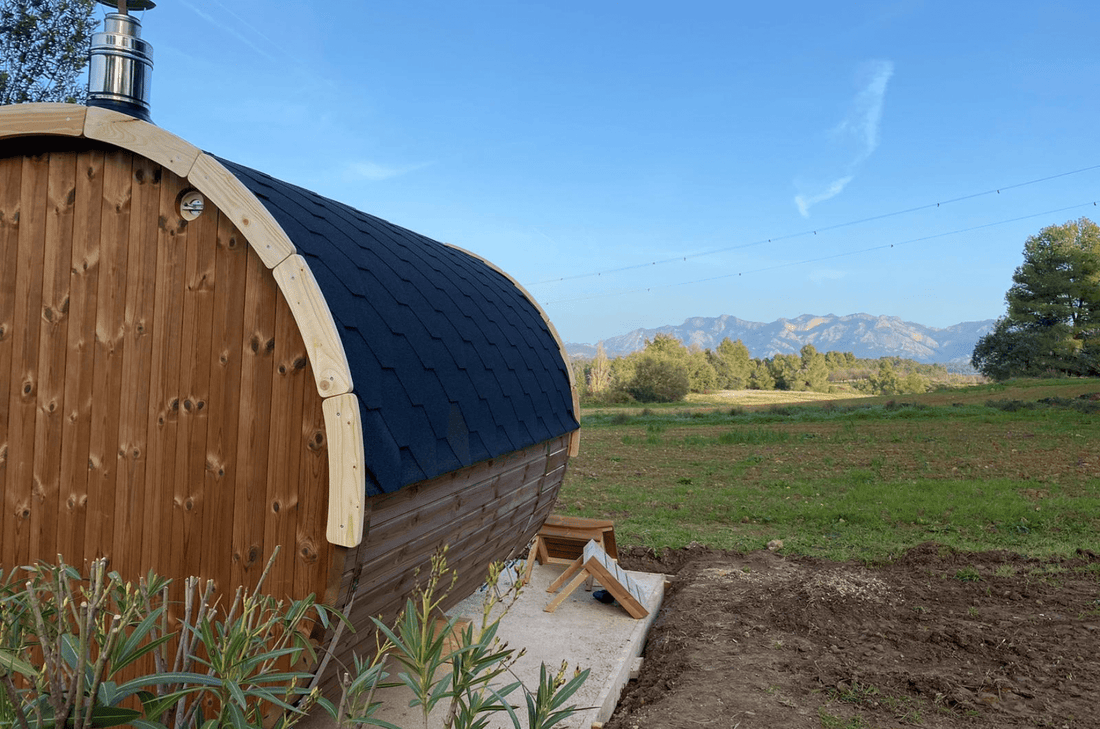A well-planned sauna purchase can turn your home into a personal spa. Buying a sauna is exciting, but it's also easy to overlook crucial details in the buying process. First-time buyers, especially those looking for outdoor saunas, often make similar mistakes that can turn a dream investment into a frustrating experience. In this guide, we'll outline five common mistakes when buying a sauna (from size and ventilation to quality and installation) and explain how to avoid them. With these tips for buying a sauna, you'll be able to make an informed purchase that will provide you with years of relaxation and well-being.
1. choosing the wrong size
One of the most common mistakes is to buy a sauna that isn't the right size for your needs. If it's too big, you'll be wasting space (and energy) heating an unused volume; if it's too small, you'll feel cramped every time you try to relax. Think about who will be using the sauna regularly - will it just be you or do you expect family and friends to use it too? Also consider the location: an indoor sauna should fit in the living room (with enough space for ventilation and safety), and an outdoor sauna needs to fit in your backyard or patio. Always measure the available area carefully, taking into account both the exterior dimensions and the interior bench space for comfortable seating. By matching the capacity of the sauna to the number of users and the space you have, you will avoid the disappointment of a sauna that is too cramped or the waste of resources of a sauna that is larger than necessary.
Saunamo Cubus sauna for 8 people installed for a client
Tip: if in doubt, opt for a slightly larger sauna if you receive guests frequently - you can always enjoy extra space, but you can't stretch a small sauna to accommodate more people!
2. Ignoring ventilation needs
Forgetting about ventilation is a serious mistake that can affect both your comfort and the longevity of your sauna. Adequate airflow makes a huge difference to the comfort and safety of your sauna. Without good ventilation, the heat can become stifling, oxygen can decrease and humidity can remain, causing mold or damage to the wood over time. All saunas - even a small outdoor barrel sauna - should have vents or a plan for air flow. Typically, the design of a sauna includes a lower intake opening (usually near the heater) and an upper exhaust opening on the opposite wall or in the ceiling, which allows fresh air to circulate and "used" air to escape. Good ventilation not only keeps CO₂ levels safe and prevents stuffiness, it also helps to dry out the sauna between uses, reducing the possibility of mold and odors accumulating.
How to avoid this mistake: choose a sauna model with integrated vents or be prepared to add ventilation during installation. For indoor saunas, make sure you vent moist air out of the house (or into a suitable adjacent space) to protect your home. For outdoor saunas, you can vent to the outside air or simply ensure that the structure has the recommended airflow openings. Don't seal your sauna so tightly that fresh air can't get in - in fact, a well-ventilated sauna feels warmer and more pleasant because the air circulates properly over the sauna users' skin. In short, plan ventilation from the outset and this will increase the longevity of your sauna + make the sauna experience much more comfortable.
3. Save on quality materials
Saving on quality is a fast track to regret when buying a sauna. It can be tempting to opt for a cheap kit or cheaper materials to save money initially, but remember that a sauna is an investment meant to last for years. Not all sauna materials are created equal, especially wood. Low-quality or unsuitable wood can warp, crack or even promote the appearance of mold in the high heat and humidity of a sauna. For example, softwoods such as poplar, alder and cedar are popular for their ability to cope with heat and humidity; they are naturally rot-resistant and stable, making them ideal for outdoor sauna cabins. In contrast, cheap, untreated wood or plywood can crack or release resinous or even toxic odors when heated. Likewise, the quality of the construction is important - thin walls with poor insulation will lose heat, and flimsy fittings or benches can break quickly.

Saunamo installation for a client in the Azores islands, where the weather can be unpredictable
To avoid this mistake, don't skimp on quality: invest in a well-regarded brand or manufacturer known for its durable construction. Look for saunas made from high-quality materials (e.g. poplar, alder, cedar) and quality heaters from reputable brands. It is also advisable to check the warranty and support - a reliable sauna supplier will guarantee their product.
At Saunamo, we only use the highest quality materials for our saunas, so our customers can feel safe in the knowledge that they are purchasing a sauna built to the highest standards. A very low price may save you a few euros now, but if the unit deteriorates or needs constant repairs, you'll end up paying more in the long run. By choosing a sauna built with quality in mind, you'll enjoy better performance, longevity and peace of mind about your purchase.
4. Choosing the wrong type of heater
There are various types of saunas and heating technologies, and buying the wrong type for your purposes is a common mistake. The two main categories are traditional saunas (heated to high temperatures with a stove and stones, where you can pour water to create steam) and infrared saunas (lower temperature, using infrared panels to heat the body directly). Each offers a different experience: if you want intense heat and steam (the classic explosion of löyly), opt for a traditional sauna; if you prefer a gentler heat for longer sessions, an infrared sauna may be the best choice for you. There are even hybrid models that combine both, but make sure you understand the advantages and disadvantages before choosing one.
Choosing the wrong type can leave you disappointed - for example, someone who loves the classic Finnish sauna ritual (with bursts of steam) won't be satisfied with an infrared sauna, and vice versa.
Another aspect is choosing the right size heater. The heater is the heart of your sauna and its importance cannot be underestimated. A small or cheap heater will struggle to reach the right temperature and may wear out more quickly from overworking. Always match the capacity of the heater to the size of your sauna (manufacturers usually specify how many cubic meters a heater can handle). For traditional electric heaters, this usually means installing a dedicated 220-240 V circuit - many larger units are not simply plug-and-play into a standard socket. Not taking this electrical requirement into account is a big mistake (which may require the intervention of an electrician to fix later).
If you're thinking of an outdoor wood-burning sauna, make sure you're prepared for what it entails: you'll need a chimney or flue for adequate ventilation, a supply of firewood and possibly local permits if wood smoke is regulated in your area. Wood-burning stoves offer an authentic, off-the-grid charm, but require more planning and effort (tending the fire and cleaning up the ashes) than electric heaters. In short, choose the type of sauna and heater that suits your lifestyle. Do you want the convenience of pressing a button to heat up (traditional electric or infrared) or do you romanticize a crackling fireplace in a cabin? Do you need the intense sweat of 80-90 °C plus steam or are you satisfied with a dry heat of 50-60 °C? Consider these questions carefully. To avoid this mistake, research the pros and cons of each type of sauna and consult experts if necessary. At Saunamo, we can explain the differences and help ensure that you get a sauna that lives up to your expectations, without any nasty surprises.
5. Neglecting installation and site planning
Buying a sauna without planning its installation is another pitfall that can cause headaches or additional costs. Whether you want to put a unit inside or build a sauna cabin outside, preparing the site is crucial. The outdoor saunasIn particular, they require a level, solid base - remember that a fully assembled sauna with several people inside can weigh well over 500 kg. You don't want it just sitting on the ground. A concrete deck or patio that can support the weight is ideal and, if you have to put it on the ground, use concrete or gravel paving underneath to prevent the structure from sinking or shifting.
Deck built for a Saunamo customer
Choose the location with a focus on practicality: consider ease of access (a conveniently located sauna will be used more), privacy from neighbors and proximity to amenities such as a shower or a power source for the heater. If it's outdoors, also think about exposure to the weather - you may need a canopy or overhanging roof to protect the sauna from heavy rain or snow. In such cases, weather-resistant wood (as mentioned in mistake #3) becomes even more important for longevity.
For indoor saunas, make sure that the room can withstand the heat and humidity (good ventilation is essential, as discussed above) and that the floor can support the weight of the sauna. Plan the electrical installation in advance: many novices underestimate the wiring needs for a sauna. In fact, not estimating the electrical requirements is considered one of the main mistakes when buying a sauna. If you are buying an electric heater, check whether it requires a special high-voltage line or a circuit of a certain amperage. Hiring a licensed electrician to install the circuit and connect the heater is generally the safest option - this is not the time to do it yourself if you have no experience, as improper electrical installation can be dangerous.
Speaking of DIY, be realistic about your assembly and installation skills. Although some sauna kits are designed for assembly by the homeowner, attempting a DIY installation without the proper skills or help can be risky and lead to improper configuration or voided warranties. Don't be afraid to hire professional installers to ensure that everything is assembled correctly, from the wall panels to the heater connections. Paying for expert installation can save you a lot of trouble in the future. Finally, check for any applicable building codes or permits - in some areas, larger outdoor structures or wood-burning stoves may require a permit. By planning the installation details (foundation, power, ventilation, permits) in advance, you'll avoid unpleasant surprises and be able to relax in your new sauna much sooner.
Conclusion and next steps
Buying a sauna is a significant investment in your health and domestic well-being. The good news is that each of these mistakes is entirely avoidable with a little foresight and guidance. By choosing the right size, ensuring adequate ventilation, investing in quality materials, selecting the appropriate type of sauna and heater and planning the installation, you'll be setting yourself up for sauna success.
If you're unsure about any step, don't hesitate to seek advice - at Saunamo, we pride ourselves on helping new sauna owners make informed choices. With expert guidance and high-quality sauna options, we're here to ensure that your sauna-buying journey is smooth and satisfying.
Avoid the common pitfalls and you'll soon be stepping into the perfect sauna, knowing you've made the best decision. Happy shopping and enjoy the heat!


